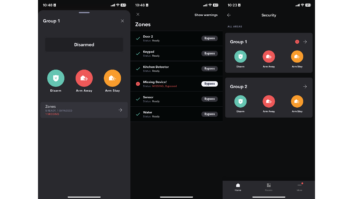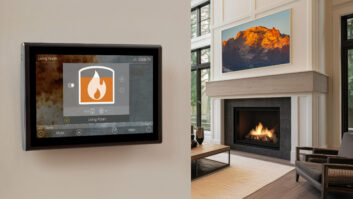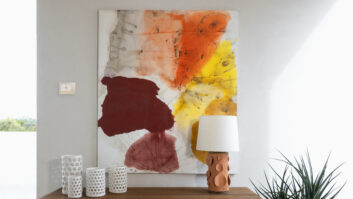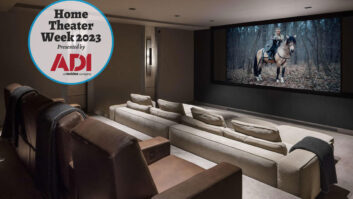The “ube” (pronounced yoo-bee) control system company that former CEDIA CEO Utz Baldwin is launching today at the DEMO trade show and on kickstarter.com, isn’t designed for the typical CEDIA-type custom installation project, but it’s not “mass market” either.
The control platform, which incorporates a mobile application that resides on iPhone or Android devices and communicates via Wi-Fi while you’re at home or through the company’s software as a service (SaaS) while you’re away from home or away from any of these devices, is intended for owners of home in the $300,000-plus price range, rather than custom estate homes of $750,000 or more that custom integrators typically target.
“The $13-billion that is being spent on the market today is being spent by wealthy Americans—people living in homes that have a value greater than $750,000,” Baldwin told me last week. “But if the cost comes down we believe we can increase the TAM [total addressable market] by at least 10 times down into homes around the $300,000 price range, which is not the playground of most CEDIA members. You should not have to have an EE degree to add a device to your system or change your system and that’s something I believe we’ve overcome.”
At the beginning of the year Baldwin connected with his co-founder Glen Burchers, who has 25 years of experience in the semiconductor business, and they began building a team working on this project with the goal of solving a problem that he says the connected home industry has faced for two decades. Namely that there are too many standards.
“What we aimed at doing was eliminating unnecessary hardware and software from the equation,” Baldwin said. “So we’ve launched a platform that utilizes the processing power of today’s mobile devices and the ubiquity of Wi-Fi in the home. Our aim is to control IP-enabled devices without the need for any additional hardware.”
According to Baldwin Ube requires no central controller, no bridge, and no dongle to operate. It simply requires a smart phone and Wi-Fi (because it is the technology most used today and the target market Ube is going after has incredibly high penetration rate with Wi-Fi). There’s no need for any other bridges because the infrastructure is already in place.
Ube will connect via smart phone to IP-based products whose manufacturers share their APIs. That enables Baldwin and his team to bring data from various products and into a single control app.
“The iPhone did a great thing by incorporating a lot of things into one device, but we’re just taking that to the next level by bring it down into one app,” Baldwin said. “There are other companies making mobile app front ends, but you have to use their hardware to make it work. There are others that are using universal remotes, but our platform is quite a bit different, first and foremost because we’re controlling all subsystems in the home. Second, it’s the intuitive nature of our platform.
Baldwin said that Ube is also incorporating gesturing into its app, so when one selects “Watch Television” to control a set-top box, instead of cluttering the smart phone’s screen with a lot of buttons, Ube essentially has a blank canvas where a simple swipe up changes the channel to a higher number and a swipe down changes the channel down. A clockwise rotation with your thumb increases the volume and counter clockwise decreases the volume.
But the Ube app is only half of the equation. The company’s software as a service monitors the status of that device, so a consumer can know what devices are on the network, how they’re configured, and how family members are interacting with them.
“That provides a great deal of information and reporting back to the user, so we can build actionable energy usage back to the consumer all the way down to the device,” Baldwin noted. “We can let them know how many hours a week their kids are watching TV, for instance, or when a specific light in a house is costing you four dollars more this month than last month.”
Baldwin told me that Ube considers itself a software company, yet is launching three key hardware devices that it believes are very “disruptive and revolutionary.”
“We chose to go the lighting and energy management route first and foremost because it lacks IP connectivity,” he said.
The first is a WiFi-enabled dimmer with capacitive touch and submetering built into it, which can be “installed in a matter of minutes” then immediately “provisioned” on a mobile phone, with no central control, no bridge, no dongle needed. “As soon as you plug a device in you can configure it. It’s very simple. Our goal was to make provisioning as easy as sending a text message, because it has to be,” Baldwin said.
The second product is an electrical outlet that allows you to turn off each of the outlets individually and has submeters for each outlet. The third device is a smart plug that allows the consumer to dim a device (a table lamp for instance), or turn it off and on from anywhere. The smart dimmer retails for $60 dollars. The app will be free for download and available in November.
Baldwin said that the “play” for the company is about the aggregation of data.
“We know which user in the house is watching what channel at what time because everyone is using their own individual smart phone. Building in the service as a service model allows for learned behavior as we start to aggregate that data, enabling us to predict and send suggestions to consumers. If you’re halfway between Chicago and Indianapolis and you’re not going to make it home on time the Ubi and can you a push notification and ask you if you want to emulate as if somebody were home, turning lights on and off.
Baldwin said he still believes the CEDIA-type custom integrator has a role to play in the business, despite his broader market approach. “There are always going to be levels of service, and the CEDIA-type integrator will continue to install high-end sophisticated control systems in estate homes. This solution was built to reach a larger audience and bring the connected home to home that have a value of 300,000 and up instead of 750,000 and up.”







